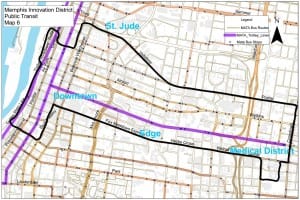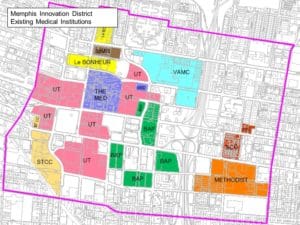Memphis, TN
Memphis, TN:
Leveraging local institutions to create an Innovation District that fosters technology commercialization for economic development and neighborhood revitalization
The Daniel Rose Fellowship Land Use Challenge for the City of Memphis is to create an Innovation District in and around the Memphis Medical Center with its concentration of hospitals, higher education and life science companies all within two miles of downtown.
This area is unique in its concentration of Life Science Institutions and related jobs in such a small geographic area. The Memphis Medical Center is home to six hospitals; medical, dental, optometry, pharmacy and nursing schools; two junior colleges; a commercial vivarium; a biotech incubator; and 60 life science firms. Those institutions employ approximately 11,000 people and attract some 450,000 visitors annually.
There is also a tremendous opportunity to build upon the existing, underutilized yet eclectic “Edge” neighborhood that abuts the Medical District to the west between it and downtown; it offers available land and appropriate zoning for mixed-use development. The Madison Avenue line of the Memphis Area Transit Authority’s heritage trolley also connects the Medical District to downtown via the “Edge” neighborhood. There are 6 stops along its 2.2 miles of double tracks, which opened in 2004 and connect with the Main Street line and Riverfront Loop downtown.
The goal is to leverage the area’s human capital, facilities and existing activity to create, attract and nurture research, development and technology commercialization in a reinvigorated mixed-use urban neighborhood.
While the area has significant assets, challenges include:
- Gaining cooperation from multiple major, independent organizations, whose primary mission may not coincide with the overall goals of the Innovation District.
- Finding ways to linking programs and individuals at various institutions in new and effective ways.
- Creating a sense of place in an area best known for its individual institutions, that helps attract additional talent and resources.
- Addressing limited street level activity. Except for Union Avenue running along the southern boundary of the proposed Innovation District and to a lesser extent Madison Avenue, the area has limited street level retail or service activity. Residential units are limited and only on the periphery.
- Finding the means to encourage private development in the area, at the same time other “Midtown” neighborhoods are being revitalized.
- Increase potential instances of “creative collisions’ and improve the likelihood of instances of innovation by transforming the Medical District into an 18 hour community and generate more full time residents.
View the study visit panel’s presentation.

